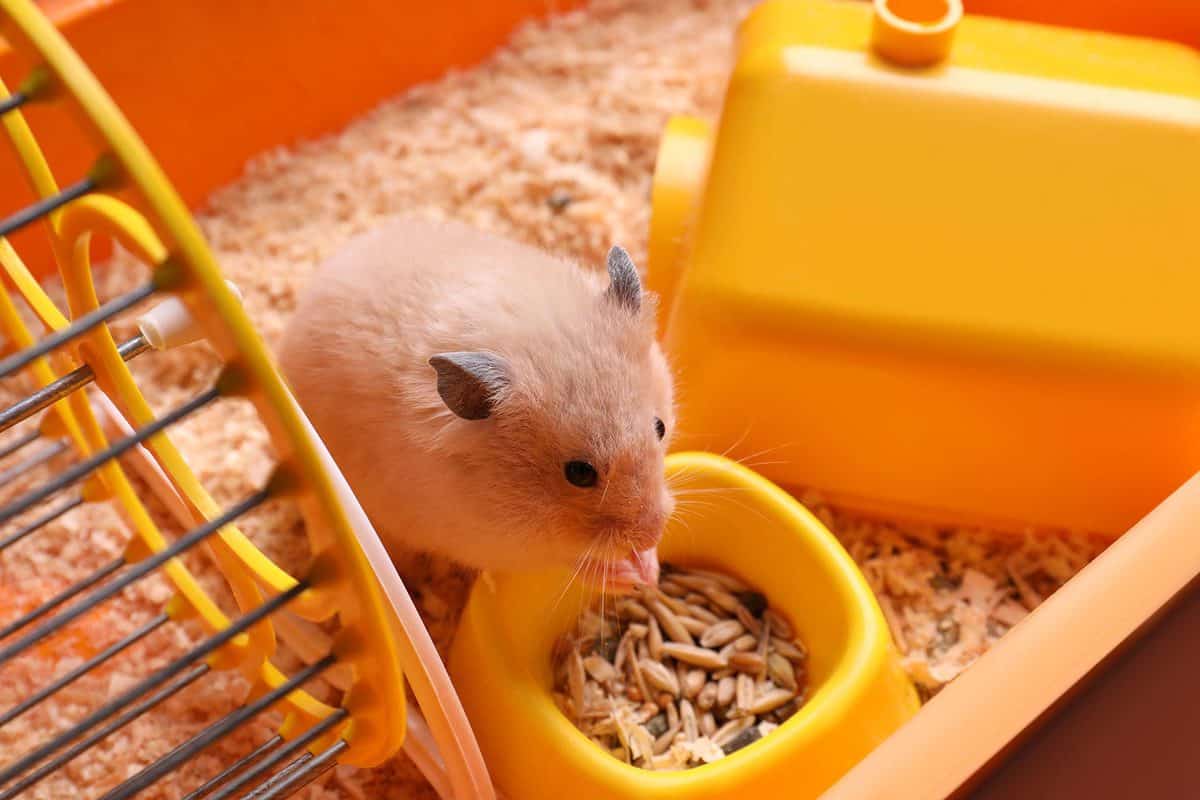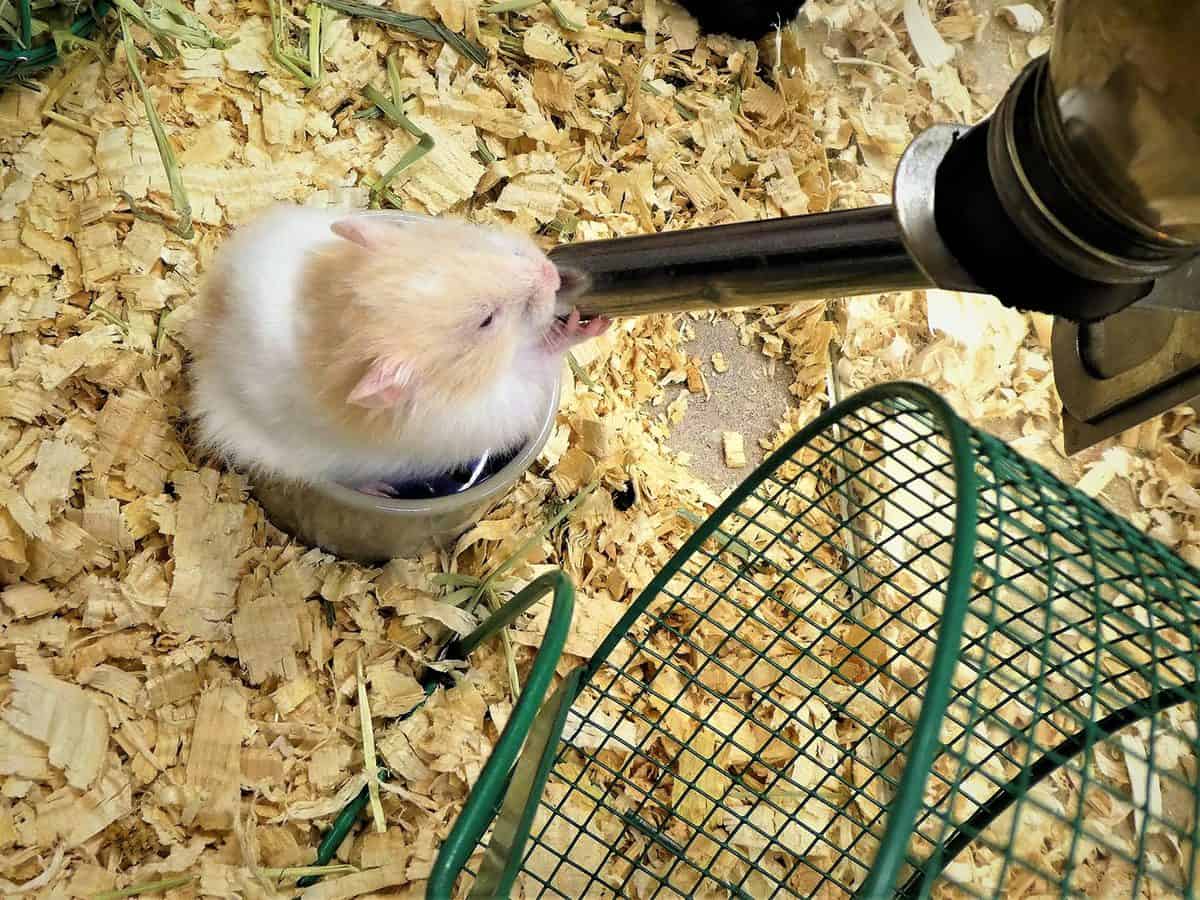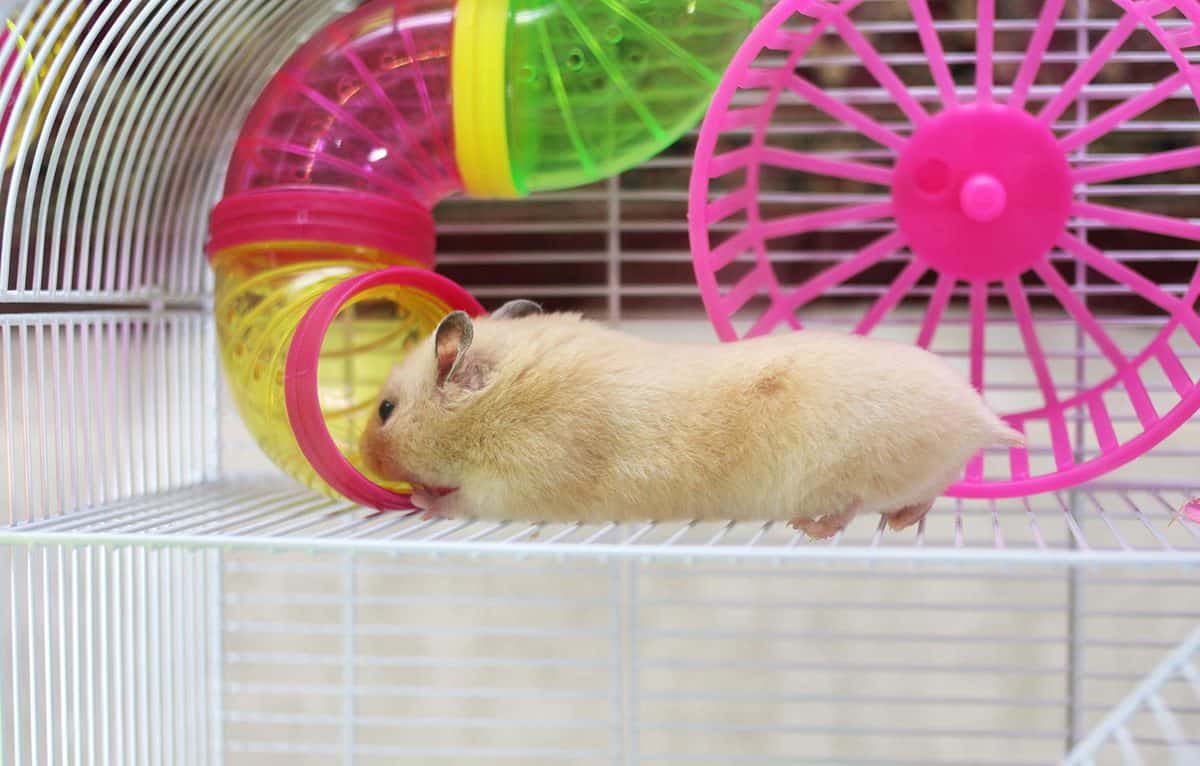Once you have chosen the largest, roomiest cage that you have space for, you are going to need to furnish your hamster’s new dwelling. This may leave you wondering what you need to put in your hamster’s cage.
My kids both had a hamster when they were younger, so I know how important this information is.
I have compiled a checklist to help you get started making your hamster feel at home!
 There are eight elements that you need to get and put in your hamster’s cage:
There are eight elements that you need to get and put in your hamster’s cage:
- Bedding: Hamsters like to burrow, so you need to give them something safe to cover the bottom of their cages, such as wood shavings and pellets made from wood, sawdust, or recycled paper. Never use pine or cedar, these woods can make your hamster sick.
- Food Bowl: Use a heavy stone bowl with a rim low enough for your hamster to reach over, but not tip over.
- Water Bottle: An inverted water bottle with a dropper works best for hamsters, as they will spill a water bowl and just make a mess.
- Exercise Wheel: Hamsters are very active so an exercise wheel is a must.
- Toys: These will keep your hamster from becoming bored in his cage. They like to climb and burrow, so anything with steps or tunnels are great.
- Hideout/Hamster House: You hamster will need a safe place to sleep, or to hide if it feels stressed or in danger.
- Bath Sand: Rolling in "bath sand" is how hamsters clean themselves. Your hamster will appreciate a container filled with special "hamster bath sand" so he can climb in and roll around. Hamsters love this!
- A hamster tunnel system: Create a fun, safe system of tunnels that provides your hamster with additional space, stimulation, and exercise.
The items listed above have great commercially available options or can be fun DIY projects.
In selecting the right product, it is very important to keep your pet's safety and well-being in mind.
Since it has been a few years since my daughter’s hamsters crossed the rainbow bridge, I did a little research to see what the best and safest products and ideas are out there today to help you choose the furnishings for your new pet’s home.
1. Bedding For a Hamster's Cage
The bedding that you choose for your hamster’s cage is the foundation upon which you will place everything else. This bedding will cover the entire floor of the cage and will be what he burrows in, day in and day out.
Bedding is also something your hamsters may chew on, use to make their bed, hide their food in, and even use the bathroom in.
There is a lot to take into consideration in purchasing this item.
Determining what will work best for your pet may take a little trial and error, depending on what your hamster likes.
Also, some hamsters have allergies to certain products so you will want to keep an eye on him for the first few days after using a new type of cage bedding.
Generally speaking, it is ideal to cover the floor of the cage with about 3 to 4 inches of wood shaving, pellets, shredded papers, hay, or grass. This will provide your hamster with a place to burrow and hide, as well as to absorb smells and urine messes.
You will also need to offer some nesting material to put in the hamster's house for him to sleep in.
This should be soft and easy to burrow into, such as shredded toilet paper, or commercial paper-based bedding.
Choosing the right bedding for your hamster
There are a lot of products available out there, but be careful as some types sold in pet stores are not safe for hamsters.
Aspen wood bedding is an excellent base as it is inexpensive, very absorbent, and great for digging in. This type of wood is not harmful to hamsters but looks similar to other wood shavings, so check the label to make sure that there are no other kinds mixed in.
Pine and Cedar wood especially must be avoided as the chemicals in the wood are harmful to hamsters and could cause damage to your pet’s lungs.
Small Pet Select Aspen Bedding is a popular option. It is made of fresh aspen wood pellets, is super absorbent, and great for deodorizing.
Paper-based bedding is good for bedding and creating a nest for your hamster. It is usually made up of recycled paper so it fluffs up to make a soft bed, and is ultra-absorbent.
Carefresh Complete Pet Bedding is soft and fluffy so it won’t scratch or harm your pet. It is white, which makes it easy to see soiled areas to spot clean.
This bedding is made from recycled wood pulp and doesn’t have inks, dyes, or chemicals that could harm your hamster. Treated to reduce bacteria, mold, and fungus, it absorbs 3 times its weight in liquid and users say that it is not at all dusty.
Whatever you do, do not use wool or cotton batting in your hamster’s cage.
You might be tempted because it is very soft and could make a good bed, but it is actually dangerous for a hamster. If he eats it or puts it in his cheek pouches, it can cause an obstruction or even suffocate him.
It is also hard for the hamster to shred and fluff, and he could get tangled in it and hurt himself.
2. Your hamster's Food Bowl

You will want to get a bowl where you can put your hamster’s food. He may stuff it into his cheeks and take it to hide it, as hamsters are food hoarders.
So don’t be surprised if he seems to be going through his food quickly. It’s probably hidden in his hamster house or buried in his bedding.

You need to put a food bowl in the cage for simple reasons of hygiene and aesthetics. It's just so much better than simply placing food on the bedding.
OMEM Ceramic Food Bowl is made from heavy-duty ceramic so it is easy to clean, hard to tip, and not chewable. This is perfect for hamsters who like to chew on everything!
3. A Water bottle

While you can give your hamster water in a bowl like the one that you feed him from, this is not the best choice as it will get dirty very quickly, either by food or debris from the bedding.
Your best bet is to get an inverted water bottle. This will keep your hamster’s water clean and accessible at all times.
It is a good idea to always have at least two water bottles in case one sticks closed, which can happen from time to time.
Always clean the bottle nozzles frequently to make sure they are in proper working order. A hamster can die from dehydration very quickly.
One example of a good inverted water bottle that I found is the Choco Nose H125 Patented No Drip Hamster Water Bottle. It has a mini leak-proof nozzle that is great for small animals, is BPA-free, and screws directly onto the side of the cage. The water bottle just snaps right off and on for easy refilling.
4. Add an Exercise Wheel

The iconic exercise wheel is a vital component of your hamster’s cage.
In the wild, hamsters can travel as much as five miles during the course of the night, always running back and forth gathering food for storage.
They love to run, so you need to make sure that your hamster gets plenty of exercise.
Running keeps hamsters healthy and happy. Hamsters that don’t get enough exercise may begin to move the ability to move freely and can ultimately become paralyzed.
A flat-surfaced wheel is recommended. The wheel should also be big enough that your hamster does not bend its back when it is running, usually 8 inches or so in diameter.
It needs to be placed on a solid flooring so it won’t tip over, and have a curved lip so your hamster does not fall out of the spinning wheel and become injured.
Be Good Pet Exercise Hamster's Wheel is a perfect example of what you are looking for. It is sleek and simple, with a solid safe wheel floor and a small lip around the edge of the wheel. It is a silent spinner, so no squeaky wheels in the middle of the night!
Hamster wheels made with wire or rungs can be very dangerous for your pet. A hamster’s legs or feet can slip through the cracks and get fractured, or even dismembered.
Be careful if you have more than one hamster, as the hamster that is not using the wheel can run underneath and get hurt. You may need to devise an alternative for exercise such as an exercise ball and extra time outside of the cage.
Read more:
Should you let a hamster out of its cage?
How Long Can You Keep a Hamster in a Ball?
5. Throw in some hamster chew toys
Hamsters are energetic and playful animals so they love toys and chews. They keep them engaged and moving, and help maintain their mental well-being.
You can make these from household items, like toilet paper tubes or Popsicle sticks, or you can purchase ready-made toys. You should switch toys out regularly so they don’t get bored of them.
Wooden toys are can be used to gnaw on which helps keep your hamster's teeth worn down. This is important to their health as hamsters’ teeth never stop growing.
Niteangel Natural Wooden Hollow Tree Trunk is a great option because is very similar to what might be found in nature. It looks like a hollowed-out tree with holes that your hamster can run in and out of, and is a good hiding spot for your little friend as well.
You could fill it with treats, or your pet may even try to use it as a sleeping area.
Another really cool wooden toy is Beaks And Paws B&P Natural Wood Hamster Train. This is ideal for dwarf hamsters because of the smaller holes, but larger hamsters can use it as a climbing and chew toy as well. It is made entirely of wood and bark so is great for chewing and gnawing on.
Hamsters love climbing and tunneling, so they also really like swings, ladders, and stairs in their cages.
The Dwarf Hamster Wooden Castle by Hamiledyi encompasses all of these needs.
It has a wooden seesaw, a platform with holes in it to climb through, and a wooden latter that leads to a small hamster hideout at the top. Other reviews said that it is great for dwarf or Robo hamsters.
You will also want some small, moveable type toys, like the Niteangel 6-Pack of Small Animal Chew Toys. These toys are made of all-natural wood, so they are perfect for chewing, and are in a variety of shapes to encourage play.
6. A Hamster House

A hamster house is very important for your pet as he needs a secluded place where he can hide and rest while feeling safe and relaxed.
Hamsters do not like a lot of noise and can get overstimulated, so having a place where your hamster can escape all the hustle and bustle and just rest is vital.
Your hamster’s house will most likely be where he builds his nest to sleep, away from prying eyes.
Many cage sets come with a hamster house, but they are usually very small and not of good quality.
You can make your pet a house out of small cardboard boxes or plastic margarine tubs with holes cut into them if you prefer, but you will have to change these out frequently as they can be chewed up.
Ceramic houses are great because they can be easily cleaned, and are not chewable. They will last for a very long time. These come in a variety of cute designs to add color and interest to your hamster's cage, like Wildgirl Adorable Hamster House which is shaped like a strawberry,
or the Small Animal Ceramic House which allows your hamster to live in a watermelon.
These are both very simple little homes which are basically just large enough for your hamster to bed down in.
There are other, more elaborate options though, like the Bwogue Hamster House Deluxe, which has bright colors and two stories with a ramp, as well as multiple entries/exits to keep your hamster entertained.
7. Bathing Sand
Hamsters should never be bathed in water, as they can get sick easily. These critters bathe themselves by self-grooming.
They may also enjoy a good roll in bath sand, which will soak up and oil or smells in their fur.
Read more: Bathing Your Hamster: What Every Owner Needs to Know
Bath Sand, also known as "chinchilla sand", is a fine sand that you will put in a bowl or container large enough for your hamster to roll around in. Most hamsters love to do this and are a lot of fun to watch!
Dwarf hamsters tend to enjoy a sand bath more than Syrian hamsters, so don’t be worried if your Syrian doesn’t care for this. He should be cleaning himself, so if he really starts to smell or look bad, check with your vet.
You must be careful to get bath sand that does not have powder or dust, as this can cause respiratory problems in your pet.
Tiny Friend Farm Hamster Bathing Sand claims to be comprised of 100% sand and totally dust-free which makes it a great option.
There are a lot of products that claim to be sand, but if you read the reviews, you will find that it is actually powder or dust or has dust in it.
Please make sure that you read the reviews before you order and once you do make a purchase if your bath sand is powdery, do not use it. Your hamster’s health depends on it.
What to put bath sand in?
Once you find quality sand that you want to use, you will need to have a good container that you can place near the edge of the cage.
When your hamster is rolling around and playing, he can kick sand out of the bowl, so having it placed near the edge will make cleanup a little easier.
If you are worried about sand getting everywhere, you can get a bath with a top on it to help prevent this. SatisPet Hamster Sand Bathroom is blue plastic with a clear lid so you can still watch your hamster play in the sand without having to worry about sand getting tossed everywhere.
8. A hamster tunnel system

Introducing a system of tunnel tubes into your hamster's habitat is great for creating additional living space. You can even connect two cages with tunnels, providing an even larger area for your hamster to explore.
Moving around the tunnels is a stimulating experience, preventing boredom and adding healthy exercise to hammy's daily routine.
See this cage with tunnels on Amazon
Or get separate tunnel parts in Amazon
What NOT to Put In You Hamster’s Cage:
Now that we know what needs to go into your pet’s cage in order to keep him happy and healthy, we need to be aware of items that might seem like a good idea or toy for your pet, but which might actually be dangerous for him.
- Do not use anything that is made of pine or cedar wood, including bedding or toys as these woods can make your pet sick.
- Beware of any kind of bathroom sand that is dusty or powdery is because it can cause respiratory issues.
- Don’t overload your cage with toys, just switch them out from time to time.
- There are a lot of foods that are poisonous for hamsters, so don’t just drop a bit of whatever you are eating into his cage. Almonds and peanuts, or some vegetables, especially unwashed ones, can make your hamster sick. If you are not sure, err on the side of caution and don’t give it to your pet. Read more: 18 Foods That Are Dangerous to Hamsters
- Do not use cat litter in your cage. It can be harmful to your hamster if he eats it (and he will!).
Have Fun Decorating Your Hamster’s Home!
There are so many amazing products in the market that are cute and useful for your hamster’s cage.
So long as you have each of the items listed above and pay special attention to ingredients that could hurt your pet, your new hamster will love his new home.
And since we mentioned these could be DIY options too, it's well worth mentioning our guide about DIY hamster cages too!
Also, we want to inform you about what cage is perfect for your hamster, you should check out 5 Types of Hamster Cages Every Pet Owner Needs To Know




















Thank you !
Thank you !
It helps me a lot !
Thank you! I just have one question, where can I buy tubes for my Syrian hamster because all of the ones I find at my local pet store are too small.
You can order online,or just make one of your own.
The Hamster Bathing Sand product that you recommend says ‘dust’ right in the description. I thought you said to avoid products with dust. This is confusing information.
true..
All you were saying is true,but not all.I do not reccomend using hamster cages with bars as pics at it can be very misleading.And please read the title of the product in the bath sand part.BUT,your information about this is bery good!!
MY hamster ? Toby love you ?